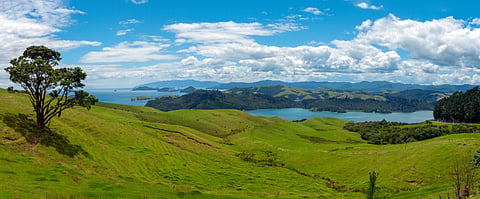

Panoramic view of the Hauraki Gulf (Tikapa Moana), North Island, New Zealand. Fisheries New Zealand has opened a consultation period on a two-year ban on the harvesting of certain shellfish species in three areas of this gulf.
Photo: Adobe Stock.
As it recently did about the kina barrens problem, Fisheries New Zealand has now opened a consultation period regarding requests from several iwi (tribes) for temporary fishing closures in three separate areas within the Hauraki Gulf. The proposed closures would affect Waiheke Island, Umupuia Beach near the Duder Regional Park, and the coastline of Te Mātā and Waipatukahu. If approved, they would prohibit the harvest of some shellfish species in these areas for two years.
"We support traditional customary fisheries management such as rāhui and consider a range of views along with the best available science and information," said Emma Taylor, Director of Fisheries Management. "This includes information we receive from tangata whenua and people who have valuable insights about what's going on in their fisheries — it's local knowledge from people who know their fishery well."
In Māori culture, a rāhui is a form of tapu (spiritual restriction) restricting access to, or use of, an area or resource by the kaitiakitanga (stewardship) of the area. Following the passing of the 1996 Fisheries Act, a rāhui was able to be imposed by the New Zealand Ministry of Fisheries, a role now played by the Oceans and Fisheries Ministry.
"We'd like to hear from anyone with an interest to understand the viewpoints and experiences of the people affected by the proposals," Taylor said about the consultation. "This information is considered alongside science and any other relevant facts to develop advice for the Minister who will make the final decision." Submissions can be made online by 5 pm on 7 June 2024.
As mentioned, it has been three tribes (iwis) - Ngāti Pāoa, Ngāi Tai ki Tāmaki, and Ngāti Tamaterā - that have expressed concern about the long-term sustainability of certain prized species (taonga) in their coastal and marine areas (rohe moana).
The three applicant iwis are members of the Pou Rāhui Research Project. This initiative incorporates Māori knowledge along with modern scientific tools to restore marine taonga species identified within the rāhui areas of their rohe. The project aims to develop iwi capacity to assess the need for rāhui and manage its implementation.
The temporary closures proposed would affect the following areas and shellfish species:
Kūtai (mussels), kōura (rock lobster), pāua, and beach cast tipa (scallops) in Isla Waiheke. The taking of other scallops is already prohibited in this area.
Tuangi (cockles) in Umupuia Beach.
Tio (oysters), kūtai (mussels), pipi, and tuangi (cockles) in Te Mātā and Waipatukahu.
"The removal of fishing pressure is an immediate way we can help these taonga species recover so they continue to provide for future generations," concluded Director of Fisheries Management, Emma Taylor.
